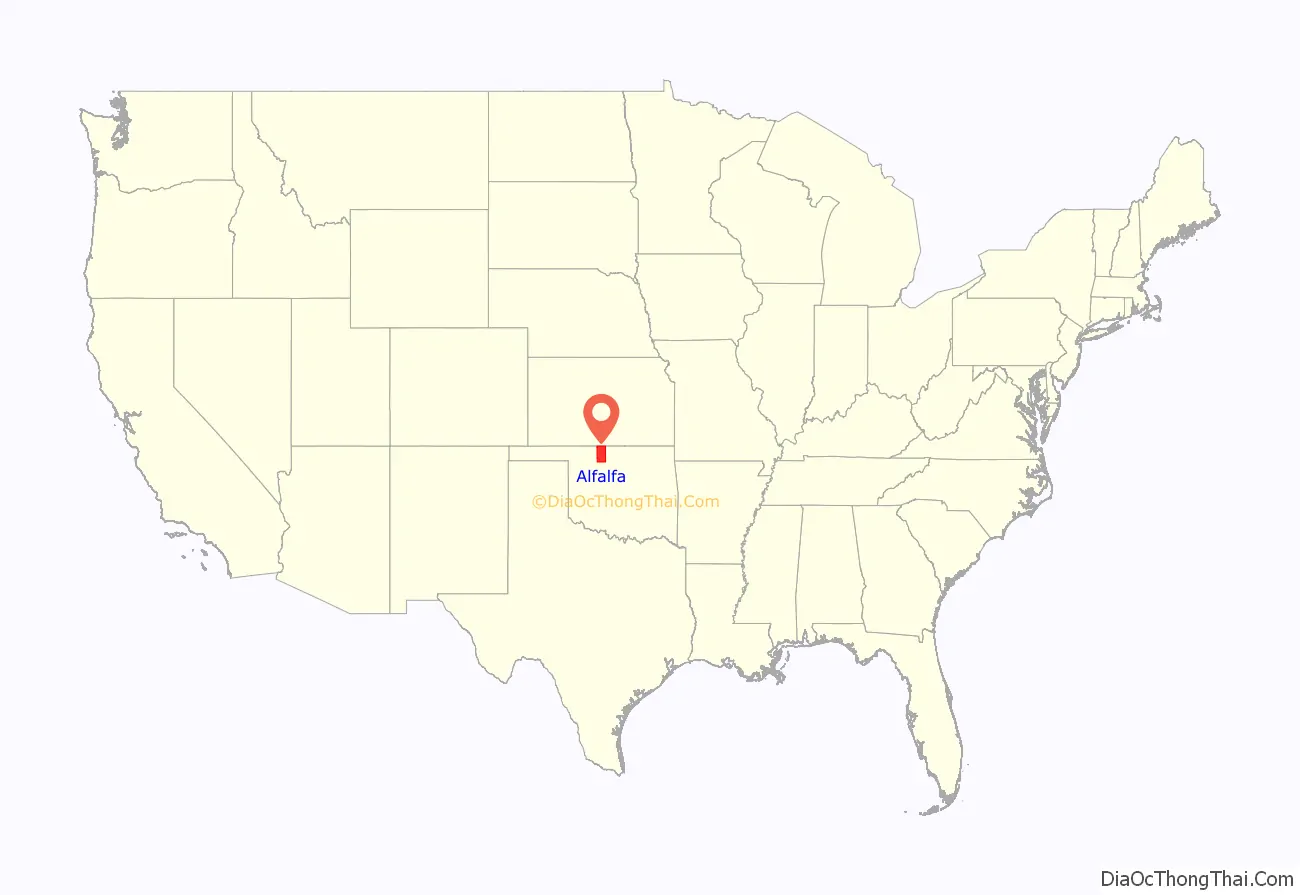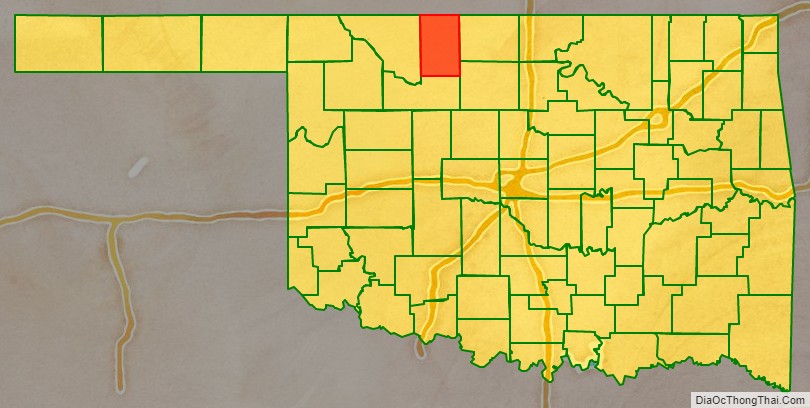Alfalfa County is a county located in the U.S. state of Oklahoma. As of the 2010 census, the population was 5,642. The county seat is Cherokee.
Alfalfa County was formed at statehood in 1907 from Woods County. The county is named after William H. “Alfalfa Bill” Murray, the president of the Oklahoma Constitutional Convention and ninth governor of Oklahoma. He was instrumental creating the county from the original, much larger Woods county.
| Name: | Alfalfa County |
|---|---|
| FIPS code: | 40-003 |
| State: | Oklahoma |
| Founded: | 1907 |
| Named for: | William H. “Alfalfa Bill” Murray |
| Seat: | Cherokee |
| Largest city: | Cherokee |
| Total Area: | 881 sq mi (2,280 km²) |
| Land Area: | 866 sq mi (2,240 km²) |
| Total Population: | 5,699 |
| Population Density: | 6.5/sq mi (2.5/km²) |
| Time zone: | UTC−6 (Central) |
| Summer Time Zone (DST): | UTC−5 (CDT) |
Alfalfa County location map. Where is Alfalfa County?
History
Early history
Indigenous peoples inhabited and hunted in this area for thousands of years. By 1750, the Osage had become a dominant tribe in the area. About one third belonged to the band led by Chief Black Dog (Manka – Chonka). Before 1800 they made the Black Dog Trail starting east of Baxter Springs, Kansas and heading southwest to their summer hunting grounds at the Great Salt Plains in present-day Alfalfa County. The Osage stopped at the springs, which attracted migratory birds and varieties of wildlife, for its healing properties on their way to hunting on the plains. The Osage name for this fork of the Arkansas River was Nescatunga (big salt water), what European-Americans later called the Salt Fork. The Osage cleared the trail of brush and large rocks, and made ramps at the fords. Wide enough for eight men riding horses abreast, the trail was the first improved road in Kansas and Oklahoma.
Pre-statehood
The treaties of 1828 and 1835 placed what would later become Alfalfa County within the Cherokee Outlet, which was owned by the Cherokee Nation. Ranching became the primary economic activity from 1870 to 1890; cattle companies that belonged to the Cherokee Strip Live Stock Association leased grazing land from the Cherokee. Prominent rancher, Major Andrew Drumm operated the “U Ranch” here as early as 1870. Its headquarters were southeast of Driftwood on the Medicine Lodge and Salt Fork rivers.
Woods County was created in September 1893 at the same time as the opening of the Cherokee Outlet with the Cherokee Strip Land Run. As population increased and Cherokee land titles were extinguished, the legislature authorized the creation of Alfalfa County in 1907, as part of statehood. The county was named after William H. “Alfalfa Bill” Murray, who served as the president of the Oklahoma Constitutional Convention and would later be elected as the ninth governor of Oklahoma. He promoted creation of this county.
Statehood years onward
The city of Cherokee, was designated as the county seat after being chosen by voters in an election held in January 1909. Other towns receiving votes for the honor were Carmen, Ingersoll, and Jet.
Alfalfa County’s population was primarily of European-American ancestry. European immigrants and their children were numerous in the early 1900s. Germans from Russia (ethnic Germans who immigrated to American from Russia), many of whom were Mennonites, settled near Ingersoll, Driftwood, Cherokee, and Goltry. Early censuses also reveal a considerable number of Bohemians from the Austro-Hungary Empire. At the turn of the twenty-first century, nearly 17 percent of county residents claimed German ancestry on the census. One Mennonite church (in Goltry) remained as of 2006.
Early railroad construction, from the Choctaw Northern line (1901), the Kansas City, Mexico and Orient (1901), the Arkansas Valley and Western (1904), and the Denver, Enid and Gulf Railroad Company (1904), contributed greatly to the county’s early prosperity and caused many small towns to flourish. They would compete as wheat-shipping points and agribusiness centers for many years thereafter. However, by 2000 only one rail line, the Burlington Northern Santa Fe, served the county.
Petroleum exploration and production has been an contributor to Alfalfa County’s economy since the time of statehood. Agricultural pursuits, including wheat farming and livestock raising, were major contributors to Alfalfa County’s economy during the twentieth century. Small-scale agriculture in its early years supported dozens of towns and dispersed rural communities, many of which no longer exist as a result of transportation and economic changes. After construction of railroads, those towns bypassed by rail service, such as Carroll, Carwile, Keith, and Timberlake, did not prosper for long.
Restructuring of the railroad industry in the late 20th century resulted in abandonment of other lines, and towns such as Ingersoll and Driftwood, for example, had declining populations that made it difficult to sustain educational and city services. Ingersoll (founded 1901) peaked in 1910 with 253 inhabitants and Driftwood (founded 1898) in 1930 with 71. By 1980, neither of these towns was still incorporated. Aline, Amorita, Burlington, Byron, Carmen, Cherokee, Goltry, Helena, Jet, and Lambert remained incorporated as of 2000.
Alfalfa County Road Map
Geography
According to the U.S. Census Bureau, the county has a total area of 881 square miles (2,280 km), of which 866 square miles (2,240 km) is land and 15 square miles (39 km) (1.7%) is water. The Great Salt Plains Lake, as well as the associated Great Salt Plains State Park and Great Salt Plains National Wildlife Refuge lie within the county, approximately 12 miles east of Cherokee. The major waterways in the county are the Salt Fork of the Arkansas River and the Medicine Lodge River.
It is part of the Red Bed plains.
Major highways
- U.S. Highway 64
- State Highway 8
- State Highway 8B
- State Highway 11
- State Highway 38
- State Highway 45
- State Highway 58
Adjacent counties
- Harper County, Kansas (northeast)
- Grant County (east)
- Garfield County (southeast)
- Major County (south)
- Woods County (west)
- Barber County, Kansas (northwest)
National protected area
- Salt Plains National Wildlife Refuge
State Park
- Great Salt Plains State Park
Alfalfa County Topographic Map
Alfalfa County Satellite Map
Alfalfa County Outline Map
See also
Map of Oklahoma State and its subdivision:- Adair
- Alfalfa
- Atoka
- Beaver
- Beckham
- Blaine
- Bryan
- Caddo
- Canadian
- Carter
- Cherokee
- Choctaw
- Cimarron
- Cleveland
- Coal
- Comanche
- Cotton
- Craig
- Creek
- Custer
- Delaware
- Dewey
- Ellis
- Garfield
- Garvin
- Grady
- Grant
- Greer
- Harmon
- Harper
- Haskell
- Hughes
- Jackson
- Jefferson
- Johnston
- Kay
- Kingfisher
- Kiowa
- Latimer
- Le Flore
- Lincoln
- Logan
- Love
- Major
- Marshall
- Mayes
- McClain
- McCurtain
- McIntosh
- Murray
- Muskogee
- Noble
- Nowata
- Okfuskee
- Oklahoma
- Okmulgee
- Osage
- Ottawa
- Pawnee
- Payne
- Pittsburg
- Pontotoc
- Pottawatomie
- Pushmataha
- Roger Mills
- Rogers
- Seminole
- Sequoyah
- Stephens
- Texas
- Tillman
- Tulsa
- Wagoner
- Washington
- Washita
- Woods
- Woodward
- Alabama
- Alaska
- Arizona
- Arkansas
- California
- Colorado
- Connecticut
- Delaware
- District of Columbia
- Florida
- Georgia
- Hawaii
- Idaho
- Illinois
- Indiana
- Iowa
- Kansas
- Kentucky
- Louisiana
- Maine
- Maryland
- Massachusetts
- Michigan
- Minnesota
- Mississippi
- Missouri
- Montana
- Nebraska
- Nevada
- New Hampshire
- New Jersey
- New Mexico
- New York
- North Carolina
- North Dakota
- Ohio
- Oklahoma
- Oregon
- Pennsylvania
- Rhode Island
- South Carolina
- South Dakota
- Tennessee
- Texas
- Utah
- Vermont
- Virginia
- Washington
- West Virginia
- Wisconsin
- Wyoming







